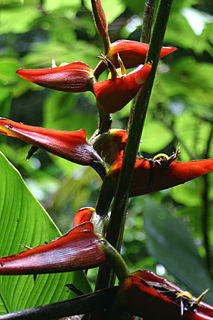
The Zingiberales are flowering plants forming one of four orders in the commelinids clade of monocots, together with its sister order, Commelinales. The order includes 68 genera and 2,600 species. Zingiberales are a unique though morphologically diverse order that has been widely recognised as such over a long period of time. They are usually large herbaceous plants with rhizomatous root systems and lacking an aerial stem except when flowering. Flowers are usually large and showy, and the stamens are often modified (staminodes) to also form colourful petal-like structures that attract pollinators.

Heliconia, derived from the Greek word Ἑλικώνιος, is a genus of flowering plants in the monotypic family Heliconiaceae. Most of the ca 194 known species are native to the tropical Americas, but a few are indigenous to certain islands of the western Pacific and Maluku. Many species of Heliconia are found in the tropical forests of these regions. Most species are listed as either vulnerable or data deficient by the IUCN Red List of threatened species. Several species are widely cultivated as ornamentals, and a few are naturalized in Florida, Gambia, and Thailand. Common names for the genus include lobster-claws, toucan beak, wild plantain, or false bird-of-paradise. The last term refers to their close similarity to the bird-of-paradise flowers (Strelitzia). Collectively, these plants are also simply referred to as "heliconias".

Heliconia acuminata is a species of plant in the family Heliconiaceae. It is an erect herb, typically growing 1.6 m tall, native to the South American countries of Brazil, French Guiana, Guyana, Suriname, Venezuela, Colombia, Bolivia and Peru. It is also grown as an ornamental plant in other regions.

Heliconia angusta Vell., of family Heliconiaceae is an erect herb typically growing 0.70 m tall, native to Brazil.

Heliconia bihai of the family Heliconiaceae is an erect herb typically growing taller than 1.5 m. It is native to northern South America and the West Indies. It is especially common in northern Brazil and the Guianas but also found in Hispaniola, Jamaica, the Lesser Antilles, Puerto Rico, Trinidad, Venezuela and Colombia. Other names by which the plant is commonly known include balisier and macawflower.

Heliconia collinsiana (platanillo) of family Heliconiaceae is an erect herb typically growing 10–15 feet (3.0–4.6 m) tall, native to Guatemala, Honduras, El Salvador, Nicaragua and southern Mexico.

Heliconia episcopalis is a species of plant in the family Heliconiaceae. It is an erect herb typically grows up to 2 meters tall, native to the Amazon Rainforest, in Colombia, Venezuela, Guyana, French Guiana, Suriname, Brazil, Ecuador, and Peru in South America.

Heliconia hirsuta is a species of flowering plant in the family Heliconiaceae. This plant is an erect herb up to 2 m tall, and it is native to Central America, South America, and the Caribbean, from Belize to Trinidad to Argentina.

Heliconia tortuosa is an herbaceous tropical perennial commonly found in secondary succession in montane forests in Central America and southern Mexico. It is moderately shade tolerant. It has also been widely cultivated as a garden plant for its showy, usually twisted inflorescences.

Heliconia rostrata is a herbaceous perennial native to Peru, Bolivia, Colombia, Venezuela, Costa Rica, and Ecuador, and naturalized in Puerto Rico. Other Heliconias grow in the upright position, their cup-shaped flower bracts storing water for birds and insects. This plant, however, has downward-facing flowers, the flowers thus providing a source of nectar to birds.

Heliconia stricta is a plant species native to Brazil, Colombia, Venezuela, Ecuador, Peru, Bolivia, Guyana, Suriname, reproducing by seeds and by underground rhizomes. It is reportedly naturalized in Cuba and Puerto Rico, and cultivated as an ornamental in many other warm regions.
Heliconia brenneri is a species of plant in the family Heliconiaceae. It is endemic to Ecuador. Its natural habitat is subtropical or tropical moist montane forest. The expansion of the road passing through its range poses a potential threat.
Heliconia × flabellata is a species of plant in the family Heliconiaceae. It is endemic to Ecuador. Its natural habitat is subtropical or tropical moist lowland forest. It is apparently a hybrid, H. episcopalis × H. rostrata.

Heliconia obscura is a species of plant in the family Heliconiaceae. It is native to Ecuador and Peru. Its natural habitats are subtropical or tropical moist lowland forests and subtropical or tropical moist montane forests.
Heliconia sclerotricha is a species of plant in the family Heliconiaceae. It is endemic to Ecuador.
Heliconia virginalis is a species of plant in the family Heliconiaceae. It is endemic to Ecuador.
Heliconia willisiana is a species of plant in the family Heliconiaceae It is endemic to Ecuador.
Heliconia is a genus of flowering plants.

Heliconia psittacorum is a perennial herb native to the Caribbean and South America. It is considered native to French Guiana, Guyana, Suriname, Venezuela, Colombia, Bolivia, Brazil, Paraguay, Panama and Trinidad and Tobago. It is reportedly naturalized in Gambia, Thailand, Puerto Rico, Hispaniola, Jamaica and the Lesser Antilles. It is often cultivated as a tropical ornamental plant in regions outside its native range. Unlike most species of plants that require the use of pollinators for pollination the H. Psittacorum naturally prefers the absence of pollinators for pollination. In other words, it is well capable of pollinating itself, any use of pollinators can do more harm than good. The flower has both male parts (anthers) and female parts, also referred to as a hermaphroditic angiosperm.

Heliconia latispatha is a plant species native to southern Mexico, Central America and northern South America and naturalized in Florida and Jamaica. It is an herbaceous perennial up to 4 m tall, with leaves resembling those of bananas. The inflorescence is erect, up to 45 cm long, with red or orange bracts subtending green, yellow or orange flowers.

